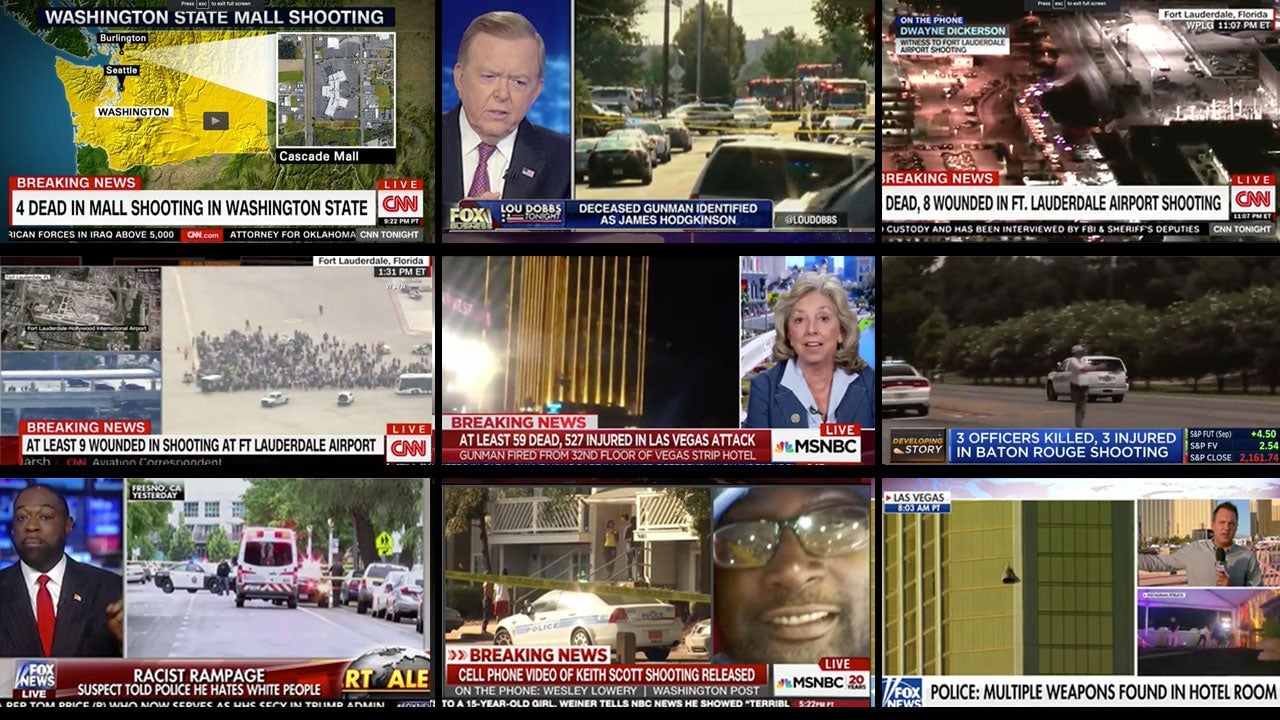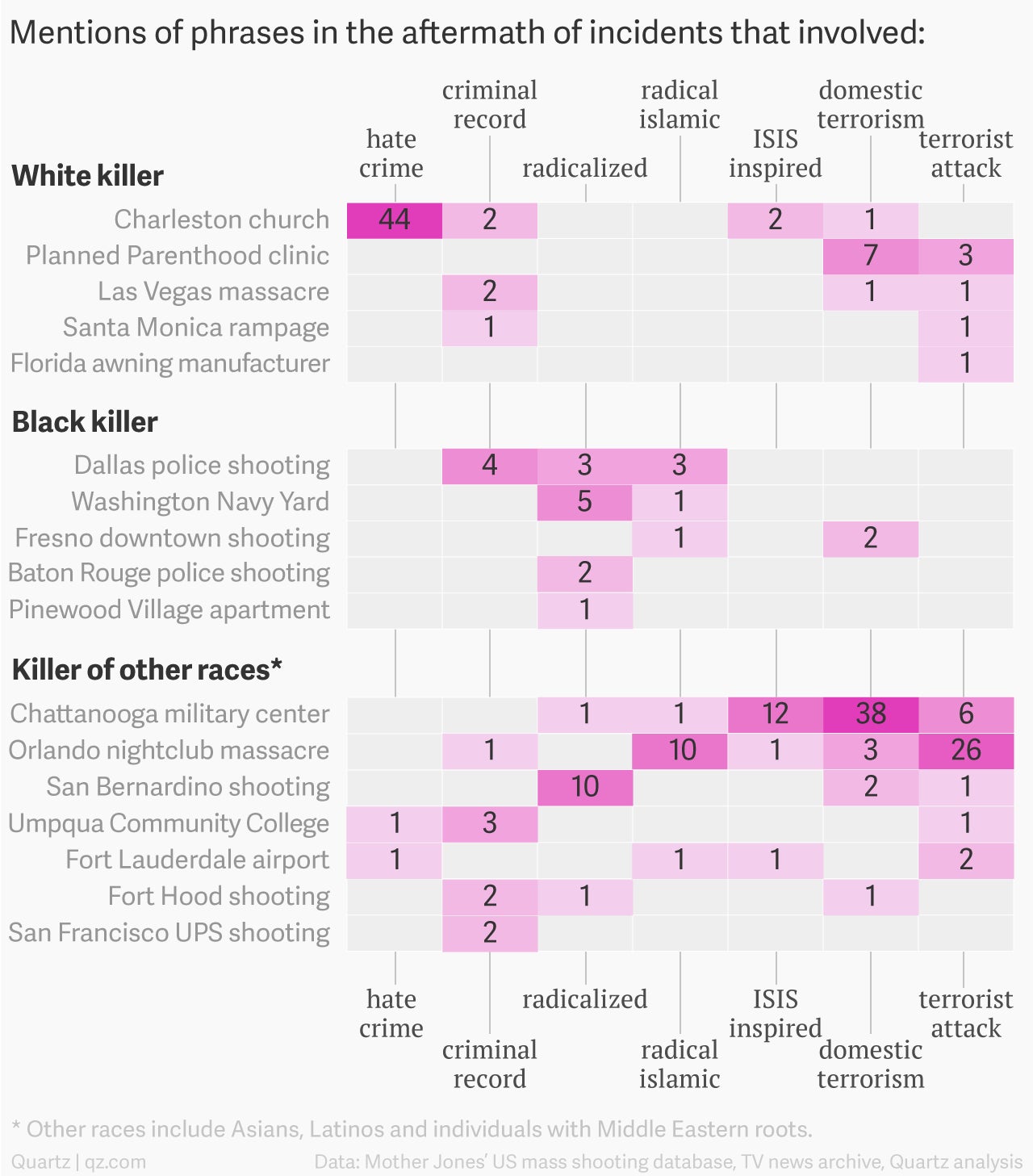Analysis of 141 hours of cable news reveals how mass killers are really portrayed
Less than 12 hours after the news of the Las Vegas shooting broke, the sheriff in charge of investigating it described the gunman as a “lone wolf.”


Less than 12 hours after the news of the Las Vegas shooting broke, the sheriff in charge of investigating it described the gunman as a “lone wolf.”
In short order, that terminology was denounced as a proxy for white privilege.
Shaun King writing for The Intercept, said that the language perpetuates a double standard: when the mass murderer is identified as white, he is seen as an individual (and called a lone wolf); when the killer is black or Muslim, the entire race or religion bears the blame. The sentiment echoed across social media as well.
Are there ingrained racial biases that surface when TV news outlets report these tragedies? Is this double standard persistent, or merely anecdotal?
Keen to answer these questions, Quartz reviewed the language used to describe the killers of 27 mass shootings in the US, beginning with the Sandy Hook Elementary School massacre in 2012.
To do this, we used a list of mass shootings maintained by Mother Jones and included only those killers where the race was ultimately identified. We then looked at transcripts from six cables news stations related to these shootings in immediate two-day period after the news broke.1
Although the term “lone wolf” was mainly reserved for white killers, it was also used in Baton Rouge police shooting in 2016 when the killer was black, and in the military recruitment center shooting in Chattanooga, Tennesee in 2015 when the killer was an American with Middle Eastern roots.
And of course, that’s not all.
A single shooter, multiple descriptors
To understand the term “lone wolf,” it’s useful to know that it was first used by FBI solely to denote a terrorist back in the early 1990s.
Mark Hamm, a criminology professor at Indiana State University, told Quartz that the use of “lone wolf” among the law enforcement community linked it strictly to terrorism. It was used to describe a single perpetrator–without help from a third party–committing violence to advance political or religious purposes. Under this framework, he says, the Las Vegas killer doesn’t qualify for the label, as at this point no clear political or religious motivations have been determined.
Our analysis shows, however, that the media often adopted a more liberal definition of the term when calling a mass killer a lone wolf. And more often than not, TV news used other terms to describe a single-shooter situation.
While “lone wolf” may convey a sense of danger or toughness, “lone gunman”, “lone shooter” and “acted alone” all deliver the same message without glorifying the killer. Hamm noted the protocol for UK scholars and law enforcement is to use “lone actor” instead of “lone wolf” for exactly this reason.
White killers and the focus on family
Our data revealed that not only were white killers tagged with the lone wolf moniker more often than non-white killers, their family members were more likely to be discussed on cable news. This is true in the case of all 27 mass shootings we looked at. The only exception, was references to wives.
Behind a killer’s motivation
After the most basic facts about a mass killer are nailed down, the search to understand motivation begins.
On the second night of the Orlando night club shooting in which the killer was a US citizen of Afghani parents, Fox News reported, “We’re working hard to understand the killer and his motives and sources of inspiration. We’re confident this killer was radicalized at least in some part through the internet.”
Hours after a white gunman killed nine black people at a church in Charleston, South Carolina, the police called it a hate crime.
As our analysis shows, a few terms were often adopted to characterize the killer and his motivations, and they shifted according to the killer’s race.
White people were rarely described as radicalized individuals. The word “radical” was not mentioned once in the 11 of 27 incidents in which the killers were identified as white, but it appeared 33 times when non-white killers were involved.
Similarly, “terrorism” was mentioned four times more frequently in mass shootings involved non-white killers than those with white killers.
When we looked at specific phrases in context of the race/ethnicity of the killers, not all phrases appeared consistently and in fact, some were attached to specific incidents more than others. For example, there were 48 mentions of “hate crime” in news related to the 27 shootings we analyzed. Forty-four of them appeared in the coverage of the Charleston church shooting, where a white man killed nine people at a historically black church.
But, when a white man shot and killed three people in 2015 at a Planned Parenthood clinic in Colorado, it was called “domestic terrorism.”

Katherine Reed, a professor at Missouri School of Journalism warned that excessive reporting on a killer’s life, beliefs and motivations portrays the killer as a celebrity and can inspire copycats.
The search for motivation, however, serves a specific function for the public: It helps separate the killer–the evil individual–from the rest of the population. As Reed wrote:
If we fixate on some aspect of the killer or the situation that is unusual — the telling detail — we can persuade ourselves that there is surely a “type” of person who is capable of doing something like this and, improbably, that we can avoid contact with this type. Or keep this type of person out of our country, if he happens to be Middle Eastern. Or keep this person locked away, if they’ve been described as having a mental illness.
The relevance of mental illness
“Mental illness” has been used as the driving factor for the violence perpetrated by white men. Our analysis found the opposite, however, mental health was more frequently discussed in TV news coverage when the killer was not white. 2
Media coverage and contagion
Jennifer Johnston, a psychology professor at Western New Mexico University, studies the effect of news coverage of mass shootings on would-be killers. She told Quartz that the choice of what to focus coverage on, and the language the media uses to describe mass killers not only shape the public perception of race and issues like mental illness and gun policies, they have a much more worrisome trigger effect for someone who’s already on the edge.
By using the word “deadliest,” the media can cue the next killer to create a new record – the next deadliest. Johnston said, “They see it as a competition.”
Studies have shown that media coverage of mass shootings can act as a contagion, and have an effect on future shootings–especially when the killer’s name and image are disclosed. In the aftermath of Las Vegas shooting, a number of scholars and law enforcement professionals have jointly published an open letter asking the media to stop publishing the name and images of the shooter.
“The media is leaning on the side that the public has a right to know… but there is a balance.” says Johnston.
Johnston also signed the letter, and told Quartz, if the media adopted the proposal not to name the offender one third of future shootings would never happen.
Additional reporting by Amirhossein Imani